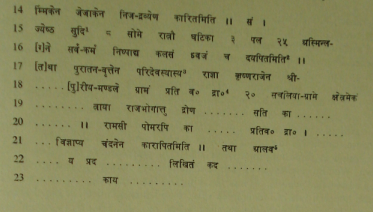|
The Indian Analyst
|
North Indian Inscriptions |
INSCRIPTIONS OF THE PARAMARAS OF BHINMAL BHINMĀL STONE INSCRIPTION OF THE TIME OF KṚISHANAARĀJA No. 93 : No PLATE ...THIS inscription was first brought to light by A.M.T. Jackson, by publishing its partial transcript with translation, in the Bombay Gazetteer, Vol. I, Pt. I (1896), pp. 473 f. It is incised, as stated by him, “on the north face of the upper square section of the more northerly of the two pillars that support the eastern side of the dome of the temple of Jagasvāmin, at Bhinmāl”, where the preceding inscription was found. Jackson did not illustrate his transcript by a facsimile of the record, and as no impression of it can now be obtained, it is edited here from Jackson’s transcript, with my notes added to it.
...The inscription contains thirteen lines of writing. It is fragmentary, Lines 6-13 are badly damaged and only a few letters in them are legible here and there; and 11. 2-5 are also full of lacunae, and some letters in them are also mutilated. Some sense, however, can be made out of them. The language is Sanskrit and the record is entirely in prose. With reference to palaeo- graphy and orthography, there is nothing worth noting. ...The inscription refers itself to the reign of the illustrious Mahārājādhirāja Kṛishṇarāja in Śrīmāla, and the object of it is to record the gift of a number of dramma made by some persons in favour of the deity installed in the temple where it was found. The record is dated in the (Vikrama)year 1132 in the dark half of Jyēshṭha, 12th Saturday, The date, as already calculated by D.R. Bhandarkar, [5] regularly corresponds to Saturday, 12th of May, 1067 A.C. The year was kārttikādi and the month pūrṇimānta.
...Beginning with the date, which we have just seen, the inscription mentions the name of the imperial ruler Kṛishṇarāja, reigning at Śrīmāla, without the family name or any of his ancestors, but from the find-spot of it there is no doubt that he is the same king referred to in the preceding inscription, dated only six years before. Following this, it mentions Chēṭaka who was the servant of the office of religion of the God Śiva (Chaṇḍīśa), and them the supreme teacher of
the Pāśupatas , who was Jāvala. Then are mentioned the names of the gold-smith Jasaṇāśa, the
[1] Read शुदि. Also read संवत्त् at the end of the preceding line and delete the punctuation mark. The figures
for the year in the preceding the may either not have been engraved or were lost, or Jackson may have omitted them is his transcript.
|
||||||||||||||||||||||||||||||||||||||||||||||||||||||||||||||||||||||||||||||||||||
| > |
|
>
|








